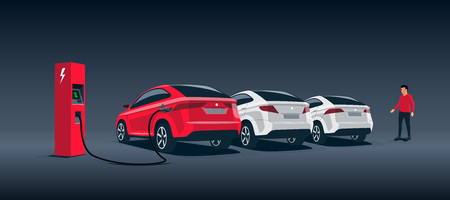1. Why Car Battery Maintenance Matters in the UK
If you’re a driver in the UK, keeping your car battery in top condition is absolutely vital. The British weather is famously unpredictable—one day it’s drizzling, the next there’s a cold snap, and sometimes you’ll get all four seasons in a single afternoon. This constant change in temperature and moisture can seriously affect your car battery’s health and performance. Combine that with frequent short journeys, stop-start urban driving, and busy commutes, and it’s easy to see why regular battery maintenance isn’t just recommended; it’s essential for avoiding breakdowns.
Regular battery care helps ensure that your car starts reliably each morning, no matter if it’s frosty outside or pouring with rain. Batteries tend to struggle most when temperatures drop or rise suddenly, which is something UK drivers experience often. Neglecting your battery can leave you stranded on the side of the road or facing unexpected repair bills.
Here’s a quick look at how UK conditions impact your car battery:
| UK Condition | Effect on Battery | Why Maintenance Helps |
|---|---|---|
| Cold Weather | Reduces battery capacity; harder engine starts | Regular checks catch weakening batteries early |
| Wet & Damp Conditions | Corrosion on terminals; risk of electrical faults | Cleansing and protection prolong battery life |
| Short Journeys & Traffic Jams | Batteries don’t fully recharge; drains power faster | Scheduled charging and checks prevent failures |
| Summer Heatwaves | Fluid evaporation inside battery; accelerates wear | Topping up fluids keeps performance optimal |
By understanding these factors and staying proactive with simple checks, you’ll keep your vehicle running smoothly throughout the year—rain or shine, cold snap or heatwave.
Common Signs of Car Battery Trouble
Spotting early signs of car battery trouble is essential for every UK driver, especially given our unpredictable weather. Knowing what to look out for can save you from an inconvenient breakdown, particularly during the chilly winter months. Here are some common warning signals that your car battery may be on its way out:
Sluggish Starts
If you notice your engine cranking more slowly than usual when you turn the key or press the start button, it’s a classic sign your battery is struggling. This can be especially noticeable on cold mornings, as low temperatures reduce a batterys efficiency.
Dashboard Warning Lights
Modern cars often have a battery-shaped warning light on the dashboard. If this light flickers or remains illuminated while you’re driving, it’s time to get your battery checked. Ignoring this could lead to more serious electrical issues down the line.
Dimming Lights and Electrical Issues
Pay attention to how bright your headlights and interior lights are. If they seem dimmer than usual, or if your electric windows and radio don’t work as well as they should, your battery might not be holding enough charge.
Quick Reference Table: Common Battery Trouble Signs
| Sign | Description |
|---|---|
| Sluggish Starts | Engine struggles to turn over, especially in cold weather |
| Dashboard Warning Light | Battery symbol stays lit or flickers while driving |
| Dimming Lights | Headlights and dashboard lights appear less bright than normal |
| Electrical Glitches | Radio, wipers, or electric windows function poorly |
Why Early Detection Matters for UK Drivers
Catching these issues early can prevent unexpected roadside mishaps, especially in remote areas or during harsh British winters. If you notice any of these signs, it’s wise to get your battery tested at your local garage or with a trusted mobile mechanic before it leaves you stranded.

3. Essential Battery Maintenance Tips for UK Roads
Keeping your car battery in great condition is crucial for hassle-free driving on UK roads, especially with the unpredictable British weather. Here’s some practical advice to ensure your battery stays reliable all year round.
Cleaning Your Battery Terminals
Corrosion on battery terminals can lead to poor electrical contact and starting issues. Check your terminals regularly and clean them if you notice any white or blue residue. You can use a mixture of baking soda and water with an old toothbrush to gently scrub away corrosion. Always remember to wear gloves and safety glasses when handling batteries.
Step-by-Step Terminal Cleaning Guide
| Step | Description |
|---|---|
| 1 | Turn off the engine and remove the keys |
| 2 | Disconnect the negative (-) cable first, then the positive (+) |
| 3 | Apply cleaning solution and scrub terminals |
| 4 | Rinse with water and dry thoroughly |
| 5 | Reconnect cables (positive first, then negative) |
Checking Battery Voltage
A healthy car battery should read around 12.6 volts when fully charged. Invest in a simple voltmeter or multimeter—these are inexpensive and easy to use. It’s a good habit to check your battery’s voltage monthly, especially before long trips or during colder months when batteries are more likely to struggle.
Voltage Guide for UK Drivers
| Battery Reading (Volts) | Status |
|---|---|
| 12.6+ | Fully Charged |
| 12.4-12.5 | Slightly Discharged (Still OK) |
| 12.0-12.3 | Needs Charging Soon |
| <12.0 | Recharge Immediately/Consider Replacement |
Seasonal Battery Checks for UK Weather
The changing seasons in Britain can have a big impact on your battery’s performance. In winter, cold temperatures reduce battery efficiency, while in summer, heat can cause fluid evaporation. Before winter sets in, check that your battery is securely mounted, the terminals are clean, and there’s no visible damage or leaks. During summer, make sure your battery fluid levels are adequate if your battery type requires topping up.
Quick Seasonal Checklist:
- Inspect for corrosion and clean terminals every season
- Check voltage monthly, especially before road trips or during cold snaps
- Tighten connections to avoid loose contacts from bumpy British roads
- If you drive short distances frequently, take an occasional longer drive to allow full charging
- If your car sits unused for long periods, consider a trickle charger to maintain battery health
By following these essential maintenance tips tailored for UK conditions, you’ll minimise unexpected breakdowns and extend the life of your car battery—keeping you confidently on the move whatever the British weather throws at you.
4. How Weather Affects Your Car Battery
For UK drivers, understanding the impact of our unique weather is crucial for effective car battery maintenance. British winters are often cold, damp, and unpredictable, which can seriously affect your vehicle’s battery life and performance. Even outside winter, frequent rain and humidity pose additional challenges. Below, we’ll explore common weather-related issues and provide practical tips to keep your battery in top condition all year round.
The Impact of Cold Temperatures
Low temperatures slow down the chemical reactions inside a car battery, making it harder for your car to start on chilly mornings. In the UK, freezing nights or early frosts can drain older batteries more quickly, especially if your journeys are mainly short trips that don’t allow the alternator enough time to fully recharge the battery.
Wet Conditions & Humidity
The UK’s notorious wet weather brings its own set of problems. Moisture can seep into battery terminals, leading to corrosion and poor electrical connections. High humidity can also cause condensation under the bonnet, which may trigger further corrosion or electrical faults.
Common Weather-Related Battery Issues in the UK
| Weather Condition | Potential Problem | Prevention Tip |
|---|---|---|
| Cold snaps & frost | Reduced battery capacity; slow engine starts | Park in a garage or use an insulated cover |
| Heavy rain & dampness | Corroded terminals; electrical shorts | Regularly clean and grease terminals |
| High humidity | Condensation under bonnet; corrosion risk | Check under-bonnet insulation and seals |
| Sudden temperature swings | Brittle or cracked battery casing | Inspect battery case regularly for damage |
Top Tips to Protect Your Battery Year-Round:
- Keep It Clean: Wipe down the battery and terminals every few months to prevent build-up of dirt or corrosion.
- Avoid Short Journeys: Combine errands to give your alternator ample time to recharge the battery properly.
- Shelter When Possible: Park in a garage or covered area during extreme weather spells to shield your vehicle from cold and moisture.
- Regular Checks: Have your battery professionally tested before winter sets in—many garages across the UK offer free battery health checks.
- Tight Connections: Ensure all cables and terminals remain tight and free from corrosion to maintain a strong charge.
A little attention during Britain’s unpredictable weather can go a long way in extending your car battery’s life and preventing those dreaded non-starts on a frosty morning.
5. What to Do If Your Battery Fails
Finding yourself stranded with a flat battery is never ideal, especially on a rainy UK morning. Here’s a practical step-by-step guide to get you back on the road safely and efficiently.
Step 1: Stay Safe and Assess the Situation
If your car won’t start, first ensure you’re parked safely, away from traffic, and switch on your hazard lights if necessary. For added safety, especially at night or in poor weather, put on a hi-vis vest if you have one in your emergency kit.
Step 2: Attempt a Jump Start Using Jump Leads
If you have jump leads and access to another vehicle with a healthy battery, follow these steps:
| Step | Action |
|---|---|
| 1 | Position both cars so their batteries are close but not touching. Turn off both engines. |
| 2 | Connect one end of the red (positive) lead to the positive terminal (+) of the dead battery. |
| 3 | Attach the other end of the red lead to the positive terminal of the good battery. |
| 4 | Connect one end of the black (negative) lead to the negative terminal (-) of the good battery. |
| 5 | Attach the other end of the black lead to an unpainted metal part on your car’s engine block—never directly onto the dead battery’s negative terminal. |
| 6 | Start the engine of the donor car and let it run for a few minutes. Try starting your own car. |
If Your Car Starts:
Let it idle for at least 10 minutes before driving off to allow some charge to return to your battery. Drive for at least 30 minutes before switching off again if possible.
If Your Car Doesn’t Start:
Double-check all connections and try again. If there’s still no luck, do not keep trying as this could damage your car’s electrical system.
Step 3: Call for Roadside Assistance
If you don’t have jump leads or another vehicle available, or if your car refuses to start after attempting a jump, it’s time to call for help. Most UK drivers have breakdown cover with providers such as RAC, AA, or Green Flag. Have your membership details ready and inform them of your exact location—using landmarks or what3words can be helpful in rural areas.
Useful Contacts for UK Roadside Assistance:
| Provider | Contact Number |
|---|---|
| The AA | 0800 887766 |
| RAC | 0333 2000 999 |
| Green Flag | 0800 400600 |
No matter where you are in the UK, staying calm and following these steps will help you manage a flat battery situation with confidence and get you moving again as soon as possible.
6. Choosing the Right Replacement Battery for UK Cars
When it’s time to replace your car battery, making the right choice is essential for reliable performance—especially given the variety of vehicle types and driving habits across the UK. Here’s a practical guide to help you pick the best replacement battery for your needs.
Consider Your Vehicle Type
Different vehicles require different batteries. For example, city cars, family estates, SUVs, and diesels all have unique power needs. Check your owner’s manual or consult with a trusted mechanic to confirm the battery size, type, and capacity recommended for your model.
Battery Types at a Glance
| Vehicle Type | Recommended Battery Type | Key Features |
|---|---|---|
| Small City Car (e.g., Ford Fiesta) | Lead Acid/AGM | Compact, affordable, suitable for frequent short trips |
| Family Hatchback/Estate (e.g., VW Golf) | EFB/AGM | Enhanced durability for stop-start tech, mid-range capacity |
| SUV/4×4 (e.g., Land Rover) | AGM/Heavy Duty Lead Acid | High cranking power, robust build for larger engines |
| Diesel Vehicles | High Capacity Lead Acid/AGM | Larger reserve power to handle higher starting loads |
| Hybrid/Electric Vehicles | Lithium-ion/NiMH (specialised) | OEM-specific; consult dealer or specialist |
Match Your Battery to Your Driving Habits
If you mostly do short journeys around town, opt for a battery designed for frequent starts and stops (look for EFB or AGM types). For those who regularly drive longer distances on motorways, a standard lead-acid or AGM battery with higher amp-hour capacity is ideal, as it can recharge more efficiently during extended runs.
Key Factors When Selecting a Replacement Battery:
- Climate: UK winters can be chilly. Choose a battery with higher cold cranking amps (CCA) if you live in colder regions.
- Warranty: Opt for reputable brands offering at least 3 years’ warranty for peace of mind.
- Fitting: Many UK garages offer free fitting when you buy a new battery—ask before purchasing!
- Sustainability: Dispose of old batteries responsibly—most retailers offer recycling schemes across the UK.
The Bottom Line: Always Double-Check Compatibility!
No matter which battery you choose, make sure it fits both physically and electrically (correct terminal layout and voltage) in your vehicle. When in doubt, consult Halfords, Kwik Fit or a local trusted garage—they’ll help ensure you get the right match for safe and smooth UK motoring.


